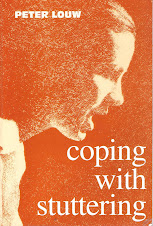To listen, click on the triangular "Play" icon at the bottom of the text below (on the left side of the black audio bar).
I have recorded a 25-minute podcast in which I talk about the Passive Airflow technique in more detail. This follows my introductory YouTube video on the technique, which you can watch by clicking HERE. I recorded the podcast to assist those people who have asked that I demonstrate the correct application of the technique.
I would once again like to emphasise that this is NOT a miracle cure. It is a management tool for better control, and it should be learned and reinforced through practice. The aim is to reduce vocal-cord tension and open the cords so that stuttering is prevented; but if you apply it incorrectly it won't work and you will become discouraged.
Back to basics!
DON'T try to apply the technique in real life if you haven't yet learned to apply it correctly in the privacy of your home. Three mistakes usually made by beginners:
1) They 'push' the flow so that it's too hard and loud. A pushed flow won't open the vocal cords correctly. A good airflow is EXTREMELY faint, passive and soft.
The criticism of the airflow technique on Stuttertalk, which you can listen to HERE, is uninformed. The participant(s) say that it sounds breathy. If it sounds breathy, you're not doing it correctly - you are pushing the flow. Beginners usually push the flow.
2) They create a pause between the airflow and speech. Actual speech should naturally and easily 'grow from the flow'; in other words, the transition between flowing and speaking should be smooth and natural.
3) They 'preform', in other words, they anticipate the sound to be pronounced, so that their lips, tongue etc. are already busy forming the sound while they are flowing out. That's the wrong way to do it. When flowing out, your lips and tongue should be in neutral positions. Only AFTER having flowed do you form the sound in a smooth and gradual manner.
I hope that you will find the podcast useful. Listen to it by clicking the 'play' button below.
PS: After having listened to myself a few times, I thought that there may have been too much pausing, but remember that English is not my first language. It is quite a challenge to 1) formulate what you're going to say 2) translate it into English, and then 3) use the airflow technique! These three steps all take time. In my first language, Afrikaans, I am actually much more fluent.
To play, click on the triangular icon below (to the left of the black audio bar below):







No comments:
Post a Comment